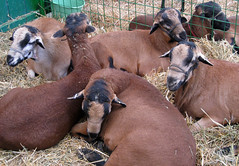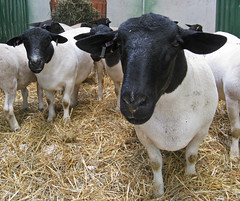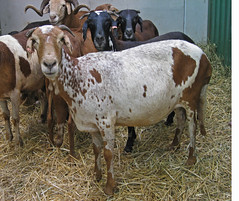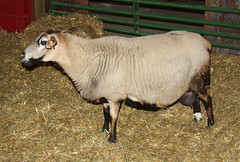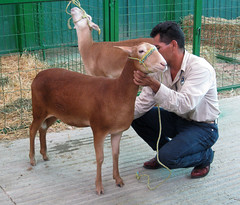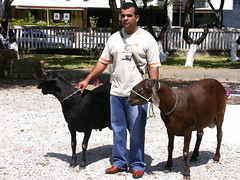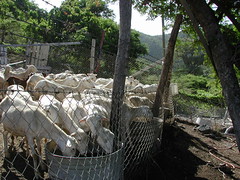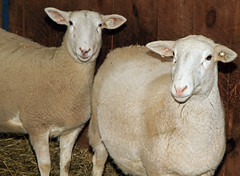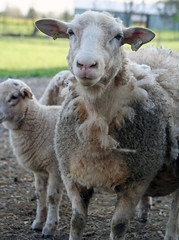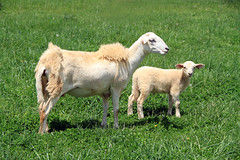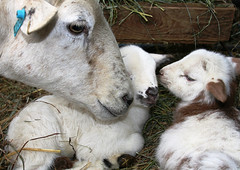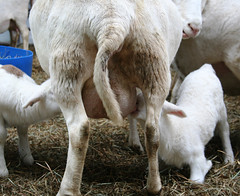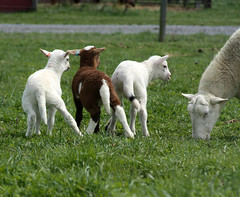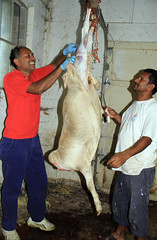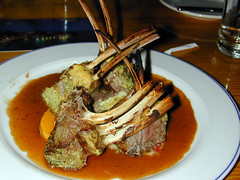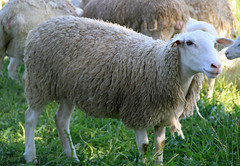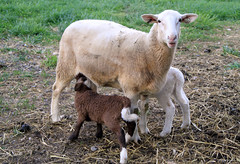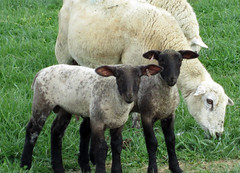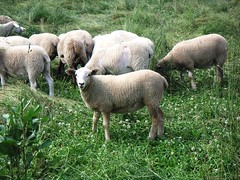- Sheep 201 Index
- Other web sites
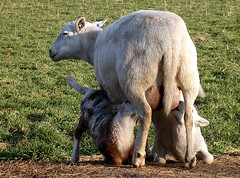
Katahdin ewe with Dorper-x lambs

Prolific Barbados Blackbelly ewe

Katahdin x Lacaune
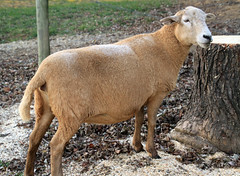
7 year old Katahdin ewe
Hair sheep primerWhile it is estimated that hair sheep comprise only 10 percent of the world's sheep population, their numbers are growing, especially in temperate climates like the United States. In 2011, 21.7 percent of US sheep operations owned hair sheep, compared to only 4.6 percent in 2001 and 1 percent in 1996 (NAHMS). Over 90 percent of the lambs sold at Producers Livestock Auction (largest sheep auction in the US) in San Angelo, Texas are now hair sheep. The top two sheep breeds in terms of breed registrations and transfers are now hair sheep: Dorper and Katahdin.
Many factors are driving the increase in hair sheep numbers, including lack of profitability in the wool sector, lack of sheep shearers, widespread development of dewormer-resistant worms, and the overall desire (need) for easy-care sheep.
Originally, all sheep were hair sheep. The Mouflon, a sub-species of wild sheep, is the ancestor to most modern domestic sheep breeds. A horned sheep, it has a short, red-brown hair coat, with a soft, woolly undercoat and short tail. Wool-bearing animals, with long, woolly tails, were the result of selecting wild sheep for their soft woolly undercoat.
Hair sheep in the U.S.
As with conventional wooled breeds, there is diversity in hair sheep breeds. In the U.S., hair sheep breeds include sheep with virtually no woolly fibers, sheep that shed their fleeces annually (and don't require shearing), and breeds whose fleeces contain too much hair to be suitable for the commercial wool market.
From a purely practical standpoint, a hair sheep is generally any sheep that doesn't require annual shearing. This can be a "pure" hair sheep, or it can be a shedding or composite breed. Some primitive sheep breeds also shed their coats (e.g. Soay, Shetland).
Hair sheep in the United States are almost all of African origin. Those that originate from the thin-tailed hair sheep of West Africa differ from those that originate from the fat-tail or fat-rump hair sheep of East and South Africa. The most popular breeds of hair sheep in the United States are composite breeds, crosses between pure hair sheep and conventional wooled breeds.
U.S. Hair sheep breeds
American Blackbelly
The American Blackbelly is a descendant of the Barbados Blackbelly. In 1904, the United States Department of Agriculture (USDA) in Beltsville (Maryland) imported a small flock of Barbados Blackbelly sheep from the Caribbean. Descendants of these sheep were later crossed with the Mouflon and Rambouillet resulting in a breed that differs from those originally imported and raised in the Caribbean.While the "crosses" go by many names, including "Barbado," the Barbados Blackbelly Sheep Association International has dubbed them the American Blackbelly, a breed similar, but distinct from the Barbados Blackbelly. The American Blackbelly resembles the Barbados Blackbelly in general appearance, but with a notable exception: the presence of horns on the rams and sometimes on the ewes. In fact, it was the massive horns of the rams that caught the attention of trophy hunters.
Other "exotic" breeds of hair sheep have since been developed from the Barbados Blackbelly (and Mouflon), including the Painted Desert, Black Hawaiian, and Corsican. While some of these exotic hair sheep are raised for production purposes, most are likely being propagated for hunting reserves.
Barbados Blackbelly
The Barbados Blackbelly originated on the Caribbean island of Barbados. Although its exact origins are unknown, the breed likely has African origins. The Barbados Blackbelly is an attractive sheep of various shades of brown, with black underparts and points, and a badger face. The sheep are leggy and resemble a small deer or antelope in appearance.In addition to being more resistant to internal parasites than wooled breeds, Barbados Blackbelly sheep are well-known for the reproductive qualities. They mature early, breed year-round, and are quite prolific. While lacking the growth rate and muscling of conventional sheep breeds, Blackbellies have value in crossbreeding programs to improve reproductive efficiency and parasite resistance. Their carcasses may also better suit some consumers.
Few "true" Barbados Blackbelly sheep remain in the United States, and so far, efforts to restore the integrity of the original breed by importing fresh genetics from the Caribbean have not been fruitful. The Barbados Blackbelly is on the "watch list" of the Livestock Conservancy.
California Red
Though classified as a hair sheep by the American Sheep Industry Association, the California Red, a cross between the Tunis and Barbado, is sheared annually and valued for its fleece. While the fleece is probably not suitable for commercial market outlets, due to the presence of too many hair fibers, it has been successfully marketed to handspinners.Dorper
The Dorper is the heaviest-muscled hair sheep breed in the US. The breed was developed in 1946 in South Africa by mating Dorset Horn rams with Blackhead Persian ewes (an indigenous fat-tailed breed). There are two types of Dorpers: the more popular White Dorper and the traditional Dorper with a white body and black head. White Dorpers and black-headed Dorpers are otherwise identical, though some breeders may have a preference between the two.Dorpers are best adapted to hot, dry climates, where they are suitable as either a ram or ewe breed. However, in moist climates, they are probably best utilized as a terminal sire, as they lack the parasite resistance of Caribbean-derived hair breeds. Dorpers do not shed as well as other hair sheep, but their carcasses are superior to the other breeds of US hair sheep. Due to their superior conformation and shedding characteristics, they have become one of the most popular registered breeds of sheep in the U.S. They are the second most numerous breed in South Africa.
Katahdin
The Katahdin is a breed of hair sheep that was developed in the United States in the 1950's by Michael Piel. The breed takes its name from Mt. Katahdin in Maine, near where the Piel farm was located. Seeing the need for meat sheep that did not require shearing, Piel imported African hair sheep (St. Croix) from the Caribbean and crossed them with the various British breeds of sheep that he had on his farm, especially Suffolk. The animals with the best characteristics eventually became the Katahdin.The Katahdin is probably the best "all-around" hair sheep in the US, as it combines the best attributes of the Caribbean hair sheep with those of the traditional meat-type wooled breeds. In most traits, Katahdins are intermediate between hair and wooled sheep.
The Katahdin is one of the most popular breeds of sheep in the United States, in terms of purebred registrations and transfers, as well as commercial production. The Katahdin is valued for its lack of need for shearing and tail docking, as well as its parasite resistance and reproductive efficiency. Katahdin ewes cross well with other breeds to produce superior market lambs. In most production systems, they are best utilized as a maternal breed.
Romanov
The Romanov is another breed that produces a fleece that is usually shorn, but is classified as a hair sheep by the American Sheep Industry Association. Both the color of its dual-coat and presence of dark guard hairs makes Romanov fleeces unsuitable for the commercial wool market; thus, the hair sheep designation by ASI.Russian in origin, the Romanov is best known for its high level of reproduction. In fact, it is one of the most prolific breeds of sheep in the world. The Romanov crosses well with other breeds, including hair sheep. The US Meat Animal Research Center in Clay Center, Nebraska, favored the Romanov breed for creating its new "easy-care" prolific breed of hair sheep: 1/2 Romanov x 1/4 Dorper x 1/4 Katahdin.
Royal White®
The Royal White was developed in the mid-1990's by William Hoag. It is one of the newer breeds of hair sheep in the US. It is a cross between the St. Croix and White Dorper. Before being trademarked, the breed was called Dorpcroix. Unbiased information about the Royal White is limited, due to its relative newness and the lack of research comparing the breed to other hair or wool sheep.St. Augustine
The St. Augustine is also a cross between the St. Croix (5/8) and Dorper (3/8). It was developed for Florida conditions. Ron Taber began development of the breed in 1991 when he began crossing a Black-headed Dorper ram with St. Croix ewes. Productivity has been the primary focus of selection. Like the Royal White®, the St. Augustine has not been objectively compared to other hair sheep breeds.St. Croix
Imported into the U.S. in 1975, the St. Croix is a mostly-white hair sheep that originated in the Virgin Islands, where is it called the Virgin Island White. The exact origins of the St. Croix are unknown, but there is speculation that it is a cross between the Wiltshire Horn and native Criollo sheep.St. Croix sheep are best known for their resistance to internal parasites. In fact, they are the most parasite resistant breed of sheep in the US. Like sheep with similar origins, St. Croix sheep excel in reproductive efficiency. They reach puberty early, breed back quickly, and produce large litters of lambs.
Commercial use of the St. Croix in the US (as a purebred) is limited by their small size, slow growth, and poor muscling, but in crossbreeding programs, the St. Croix has much to offer the commercial sheep industry. Researchers value the St. Croix for its strong immune response to parasites and are using the breed as a model to study the genetic basis of parasite resistance.
Wiltshire Horn
The Wiltshire Horn is an old breed of hair sheep native to England. As its name implies, both sexes carry horns. Wiltshires grow a short fleece of wool that is shed annually. With the rising popularity of hair sheep, Wiltshire Horns have been "rediscovered" in the UK and other places where they are being used to develop improved breeds of hair sheep (e.g. Wiltipoll and Easy Care). At one point, the Wiltshire Horn was crossed with the Katahdin to improve size and carcass quality, but selection against horns gradually diminished its influence.Other breeds
Several other breeds of hair sheep can be found in the Americas, and it is possible that some of these breeds may eventually find their way into the US, if not already. The Wiltipoll is a Wiltshire Horn cross that was developed in Australia. The Pelibüey and Santa Inês are of Caribbean/West African ancestry and would be expected to have similar attributes as the hair sheep breeds already here.The mostly red Pelibüey comprises more than 75 percent of Cuba's sheep population. It is raised throughout the Caribbean and Mexico. The Santa Inês is a multi-colored Brazilian hair sheep that is larger and longer-legged than other hair sheep breeds. Two breeds of South African hair sheep, the Damara and Meatmaster, are currently being raised in Canada. The Damara is a fat-tailed sheep, best adapted to arid climates. The Meatmaster is an improved hair sheep, developed by crossing fat-tailed sheep (e.g. Damara) with well-muscled British and European breeds. Like its parent breeds, it is probably best adapted to arid climates.
Management
People are initially drawn to hair sheep because of their lack of need for shearing. In addition, there is not much money in wool these days, unless you produce superfine wool, direct market fleeces to hand spinners, or add value to your clip. Consequently, wool tends to be a cost of production for most producers, often costing more to take it off and get it to market than what it brings in the marketplace. Thus, there has been a growing transition to hair sheep.
Hair sheep have coats with few woolly fibers, or they have coats that contain a mixture of hair and wool fibers which shed naturally (usually annually). In fact, all sheep have hair and wool fibers. Sheep with more wool fibers usually have to be sheared, whereas sheep with more hair fibers usually shed their coats naturally and do not require shearing. As hair sheep move to more northern climates, they tend to grow more woolly fibers (to keep them warm). In the wintertime, their coats looked similar to wooled sheep.
There are significant differences in shedding among and between breeds. There are breeds and individual animals with few woolly fibers and others that grow thick "woolly" coats for the winter and shed their coats annually. Shedding usually commences in the spring when the weather starts to change. Some sheep will start to shed in the winter. Some will not shed until late spring or early summer. Shedding varies from year-to-year.
All sheep should be fully shed by the middle of summer. Obviously, the ones that do not fully shed are less desirable than those than do. Many lambs will shed out during their first summer, but lambs that do not shed their first summer may still be good shedders as adults. In fact, shedding often improves with age. It may also diminish with advanced age.
Shedding is not "pretty." For those who have never raised hair sheep, it takes some getting used to. People who have never seen shedding sheep might think there is something wrong with them. It is helpful if the sheep have something to rub on. Being exposed to rain will also help. It is not necessary to pick up the shedded fleece. Often, loose patches of wool can be easily pulled from sheep. Hair sheep that require shearing should probably be culled, unless they are part of an upgrading program or only used to produce market lambs.
Shearing
If hair sheep or hair x wool crosses are sheared, they should be sheared last and their fleeces should be discarded. The fleeces from hair sheep or hair x wool crosses will contaminate a wool clip, and under no circumstances should they be mixed with wool fleeces or taken to a wool pool, warehouse, or woolen mill. It is possible that the fleeces from hair sheep or hair x wool crosses could have some practical use or economic value, such as stuffing for archery targets or insulation.Producers who aim to produce high quality wool should probably not mix hair sheep with wooled sheep, especially when the hair sheep are actively shedding. It is possible that hairs from the hair sheep will get into the fleeces of the wooled sheep. Hair (also called kemp) is very undesirable in wool processing. Hair does not have crimp and it will not accept dye. Too much hair can ruin the reputation of a good wool clip.
Crutching
Crutching is a quick modification of shearing. It is when the wool in the vulva area and around the udder is removed. It creates a cleaner lambing environment and helps to prevent lambs from latching onto a tag or piece of wool instead of a nipple. It is usually not necessary to crutch hair sheep ewes. It may be advisable to crutch some hair x wool crosses.
Docking
It is usually not necessary to dock the tails of hair sheep lambs. This is because the tails of hair sheep are not as thick and woolly as the tails from wooled sheep. It may be advisable to dock the tails of some hair x wool crosses. Dorper lambs are often docked.Hair sheep tails do not "get in the way" of breeding. It is natural for a sheep to have a tail. It protects a sheep's private parts and is used to help scatter the feces when it defecates. Thick, woolly tails were an unintended consequence of selecting sheep for woolly coats.
Resistance to internal parasites
Another important reason for the growing popularity of hair sheep is their improved resistance to gastro-intestinal parasites (stomach or roundworms). Internal parasitism is one of the major obstacles to profitable sheep production, especially in warm, moist climates or in production systems where lambs will be finished on pasture. The widespread development of drug-resistant worms has made effective control even more challenging. The use of sheep that are genetically more resistant to parasites is seen as an important tool in the fight against internal parasitism.
The hair sheep breeds that trace their ancestry to the Caribbean and West Africa (i.e. tropical climates) are known for their resistance to internal parasites. In the US, these include the Barbados Blackbelly and St. Croix. The parasite resistance of composite breeds, such as the Katahdin, is intermediate between hair sheep and wooled sheep, since Katahdins are a cross between the resistant St. Croix and non-resistant British breeds. Crossing the Katahdin with another wooled breed would be expected to further reduce the parasite resistance of the resulting offspring, though the hybrid vigor of the crossbred lambs may improve parasite resistance and resilience.
At the same time, it is important to know that no breed of sheep is completely resistant to internal parasites. If the parasite challenge is severe enough, any sheep, especially lambs, can succumb to the effects of worms. As with traditional wooled sheep, hair sheep still need to be monitored for signs of internal parasitism and managed accordingly. In addition, there is NO evidence to suggest that hair sheep are more resistant to protozoan parasites (e.g. coccidia). In fact, there is a theory that sheep that are more resistant to intercellular (worm) parasites may be more susceptible to coccidia (intracellular parasites).
Reproduction in hair sheep
Compared to most conventional breeds of wooled sheep, hair sheep tend to have superior reproductive qualities. They reach puberty early and have high rates of fertility and fecundity. They are less seasonal than most wooled sheep and breed back more quickly. They are usually good mothers and milkers. Their lambs are usually lively and vigorous. Males tend to be aggressive breeders.
With good management, the mature ewes of most hair sheep breeds are capable of producing lamb crops in excess of 200 percent. They are suitable for accelerated or fall lambing programs. At the same time, it is important to remember that differences exist not only between breeds, but within breeds as well. Not all hair sheep will breed out-of-season. Health, nutrition, and management also have large effects on flock reproduction.
Feeding hair sheep
Because most hair sheep fatten differently than wooled sheep (from the inside out, more like a goat), they should probably not be fed the same or fed to the same degree of external finish as conventional wooled lambs. This is because a hair sheep lamb that has 0.25 inches of backfat will have considerably more internal fat than a similarly finished wooled lamb. This is especially true of the "pure" hair sheep breeds, such as St. Croix.
Because of their easy-care qualities, hair sheep lambs are often "fattened" on pasture instead of in feed lots. Pasture diets allow lambs to grow more slowly. They are less likely to get overfat. Though there are many factors that affect meat quality, grass-fed lamb tends to have a more favorable fatty acid composition than grain-fed lamb.
At the same time, there is nothing wrong with feeding some grain (or other supplements) to hair sheep lambs. In fact, it will likely improve their growth performance and could prove to be a more economical feeding system in some situations. Fed lambs have more "bloom" and usually bring higher prices at sale barns and other terminal markets. However, hair sheep lambs should probably not be put on full or self-feed. If you feed them lesser amounts of grain and more forage, this will allow them to gain frame before fat and finish at heavier weights.
Hair sheep breeding stock should not be allowed to get as "fat" as conventional wooled breeds. If a hair sheep ewe has a high degree of external fat, she will have more internal fat than a wooled sheep in similar body condition. There is only so much room in a ewe. If she is full of forage, fat, and babies, she may have trouble keeping everything inside. She is also more likely to experience lambing difficulties if her body cavity contains excess fat.
At the same time, there are consequences to having ewes too thin. Maintaining sheep in the proper body condition can be challenging as some sheep are easy-keepers while others seem to be perpetually thin. Producers should strive to keep body condition scores between 2 and 4 (out of a possible 5). A body condition score of 3+ is desirable at the time of breeding and lambing. In pasture-based production systems, a body condition score of 2.5 to 3 may be more acceptable at the time of breeding and lambing. Older ewes often have a more difficult time maintaining body condition. They should be culled once this happens.
As with wooled sheep, hair sheep lambs that will be retained for breeding should not be overfed. There is some evidence to suggest that overfeeding prepubertal females can have a detrimental effect on lifetime milk production, as overfeeding results in the deposition of fat in the udder. Overfeeding can also have a negative effect on semen quality in the male.
Growth and carcass quality
Internal fat
As previously mentioned, many of the hair sheep breeds fatten more like goats, from the inside-out. As compared to most wooled breeds, they deposit more fat around their internal organs (kidney and heart). When compared at an equal degree of finish (12th rib back fat depth), the carcasses from hair sheep lambs will have a higher percentage of kidney and heart fat than their woolly counterparts. Dorpers are an exception, as they fatten similarly as wooled sheep.Finish weights
Because they are small or medium-sized breeds, hair sheep lambs should not be fed to as heavy weights (e.g. over 130 lbs.) as this will likely result in overfat carcasses with significant amounts of kidney and heart fat. Finish weights can be increased by crossing hair sheep ewes with larger-framed terminal sire breeds, but the lambs will still not finish as heavy as crosses between western white-faced ewes (e.g. Rambouillet) and large terminal sire breeds (e.g. Suffolk). Finish weights will also vary with the genetics of hair sheep. For example, there are some Katahdin and Dorper ewes that weigh over 180 lbs. and will be able to produce lambs that finish at heavier weights, especially when crossed with terminal sire breeds.Because of their smaller mature weights, many hair sheep are better suited to the ethnic markets that tend to prefer lambs less that weigh than 100 lbs. In fact, many ethnic customers show a preference for hair sheep lambs.
Flavor
There is some evidence to suggest that the meat from hair sheep has a milder (less "muttony") flavor than the meat from wooled breeds. Research has always shown a correlation between wool fiber diameter (fineness) and lamb flavor, with fine wool lambs having a more intense flavor than coarse-wooled lambs. Research has shown Dorper lamb to be more tender than the lamb from other breeds, though the differences may not be discernible by consumers.Fatty acids
There is some evidence to suggest that the meat from hair sheep lambs may have a more desirable fatty acid composition than the meat from conventional wooled breeds. At the same time, it is important to realize that research evidence is largely lacking, and most quality differences attributed to hair sheep lamb (or lamb from any other breed type) are purely anecdotal. Furthermore, diet will likely have a far greater effect on lamb flavor and fatty acid composition than the breed type of the lamb.
Disposition
Though some breeds are noted for the flighty dispositions, the disposition of sheep is largely affected by their care and management rather than their breed. Sheep that are housed and hand fed will more readily accept handling than those that are raised under extensive pasture conditions with limited human contact. Sheep can be "taught" to voluntary accept restraint. They will remember bad handling experiences. Lambs that are handled when they are young will be less fearful of handling.
It is advisable to cull any sheep that is overly aggressive or nervous, especially if the sheep will be frequently handled. In cattle, disposition is a moderately heritable trait that is considered to have economic importance.
Milk goiter
Milk goiter is common in hair sheep. It is a normal enlargement of the thymus gland, a part of the normal maturation of the immune system in juvenile animals. This throat swelling should not be confused with goiter, an abnormal enlargement of the thyroid gland; or "bottle jaw," an accumulation of fluid under the jaw of a severely parasitized animal.
Crossbreeding with hair sheep
Hair sheep are ideal for crossbreeding. There are several reasons for crossing hair sheep. The most compelling reason to crossbreed hair sheep with other breeds is to take advantage of breed complementarity. Breed complementarity is when weaknesses of one breed are offset by the strengths of the other breed(s) and vice versa. With the exception of the Dorper, hair sheep tend to excel in fitness and reproductive traits, whereas they lack the growth and carcass quality of some of the meat-type wooled breeds.
Thus, by crossing hair sheep ewes with meat-type wooled rams (e.g. Suffolk, Hampshire, Southdown, or Texel), superior market lambs will be produced, while not affecting the fitness and reproductive qualities of the ewe flock. All of the lambs from this terminal cross would be slaughtered. Ewe lambs would not be kept for breeding.
Crossbreeding hair sheep with most traditional wooled breeds will likely improve the reproductive performance of the wooled flock. After several generations of crossing with hair sheep rams (and saving the crossbred females), the need for shearing the ewe flock can be eliminated. This was a common practice when hair sheep were scarcer.
Among the hair sheep breeds, Katahdin x Dorper is the most popular cross. In this cross, the parasite resistance, better shedding qualities, and higher reproductive rate of the Katahdin is balanced with the superior conformation of the Dorper. Crosses between the Dorper and St. Croix have resulted in the development of two new breeds: Royal White® and St. Augustine.
Hybrid vigor (or heterosis) is another compelling reason for crossbreeding. Hybrid vigor is when the performance of the crossbred offspring is superior to the average performance of the parent breeds. Hybrid vigor is expressed in both the crossbred offspring and the crossbred female. Crossbred males tend to be more fertile and aggressive. Composite breeds, such as the Katahdin and Royal White®, still retain some level of hybrid vigor.
Hair sheep primer
<== SHEEP 201 INDEX
Copyright© 2021. Sheep 101 and 201.



